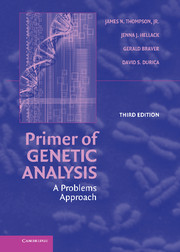Book contents
- Frontmatter
- Contents
- Preface
- Note on Genetic Symbols
- 1 Overview of Genetic Organization and Scale
- 2 Mitosis and Meiosis
- 3 Nucleic Acids: DNA and RNA
- 4 Basic Mendelian Genetics
- 5 Probability and Chi-Square
- 6 Sex-Linkage and Gene Interactions
- 7 Pedigree Analysis
- 8 Overview of Basic Statistical Testing
- 9 Quantitative Inheritance
- 10 Overview of Genetic Mapping
- 11 Assessing Chromosome Linkage Relationships
- 12 Linkage and Mapping in Diploids
- 13 Mapping in Bacteria and Viruses
- 14 Overview of Types of Genetic Change
- 15 Gene Mutation
- 16 Changes in Chromosome Number and Structure
- 17 Protein Synthesis and the Genetic Code
- 18 Gene Regulation and Development
- 19 Overview of Molecular Biology Techniques
- 20 DNA Mapping and Human Genome Analysis
- 21 Basic Population Genetics
- 22 Selection and Evolution
- 23 Practice Tests
- 24 Answers to Practice Tests and Crossword Puzzles
- 25 Landmarks in the History of Genetics
- Glossary
- Reference Tables
20 - DNA Mapping and Human Genome Analysis
Published online by Cambridge University Press: 05 June 2012
- Frontmatter
- Contents
- Preface
- Note on Genetic Symbols
- 1 Overview of Genetic Organization and Scale
- 2 Mitosis and Meiosis
- 3 Nucleic Acids: DNA and RNA
- 4 Basic Mendelian Genetics
- 5 Probability and Chi-Square
- 6 Sex-Linkage and Gene Interactions
- 7 Pedigree Analysis
- 8 Overview of Basic Statistical Testing
- 9 Quantitative Inheritance
- 10 Overview of Genetic Mapping
- 11 Assessing Chromosome Linkage Relationships
- 12 Linkage and Mapping in Diploids
- 13 Mapping in Bacteria and Viruses
- 14 Overview of Types of Genetic Change
- 15 Gene Mutation
- 16 Changes in Chromosome Number and Structure
- 17 Protein Synthesis and the Genetic Code
- 18 Gene Regulation and Development
- 19 Overview of Molecular Biology Techniques
- 20 DNA Mapping and Human Genome Analysis
- 21 Basic Population Genetics
- 22 Selection and Evolution
- 23 Practice Tests
- 24 Answers to Practice Tests and Crossword Puzzles
- 25 Landmarks in the History of Genetics
- Glossary
- Reference Tables
Summary
STUDY HINTS
The techniques described in the previous chapter can be used to map DNA at several different levels of resolution over several different degrees of scale. At the nucleotide level, a linear array of bases can be ordered by DNA sequencing. Using the techniques currently available in most laboratories, each sequencing experiment resolves contiguous regions on the order of hundreds to thousands of nucleotides. Using cloned DNA and batteries of restriction enzyme digests, a linear array of restriction sites can also be mapped relative to one another. Mapping via restriction enzymes can be used to order DNA regions thousands to tens of thousands of nucleotides in length. Finally, techniques of nucleic acid hybridization can be applied to locate genes to specific chromosomal regions, where any chromosomal band identifiable cytologically contains millions of base pairs.
What advantages are there to localizing genes? One advantage that has already gained clinical importance is the ability to follow the transmission of certain genetic diseases using tightly linked genetic markers. The recent application of recombinant DNA technology to gene mapping is having tremendous significance in identifying DNA sequences that are highly variable in populations, and whose inheritance pattern can be used to follow the transmission of closely linked disease genes. Moreover, once a search has been narrowed to a specific region of the genome by establishing linkage to a particular marker, molecular techniques can be brought to bear on finding and cloning the disease gene itself.
- Type
- Chapter
- Information
- Primer of Genetic AnalysisA Problems Approach, pp. 197 - 215Publisher: Cambridge University PressPrint publication year: 2007



